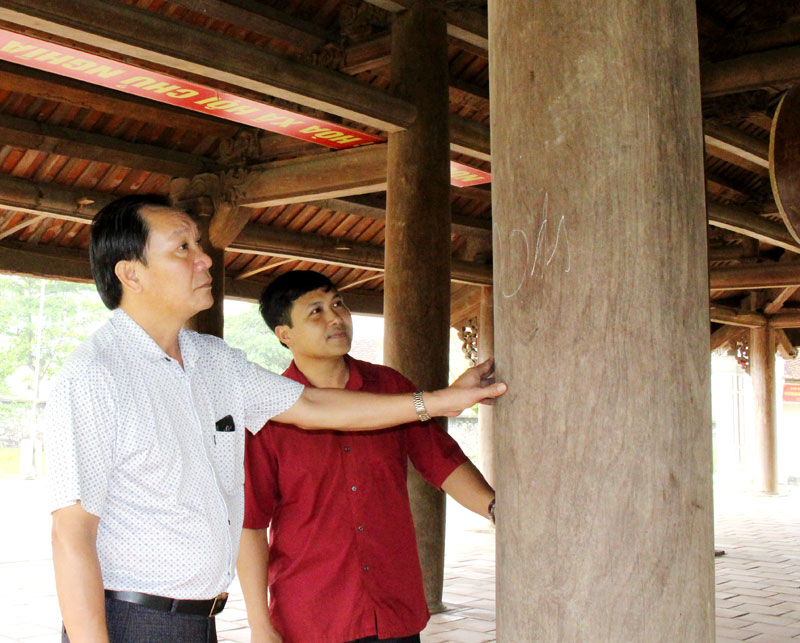
(HBO) - Yen Thuy district has a system of religious establishments such as temples and pagodas that contain many historical and cultural values associated with the unique cultural belief of the local people. They include 12 cultural and historical relics, scenic spots, three of which have been ranked as the national and 9 have been ranked as provincial ones. Recently, these relics have been invested and restored to serve the tourism development.
 The cultural staff of Phu Lai commune (Yen Thuy) is checking the items at Xam Temple for the restoration and conservation plans to develop tourism.
The cultural staff of Phu Lai commune (Yen Thuy) is checking the items at Xam Temple for the restoration and conservation plans to develop tourism.
Mr. Bui Trong Thuy, the Head of the Department of Culture and Information of Yen Thuy district says that on April 21, 2017 the People's Committee of the district issued Plan No. 41/KH-UBND on the implementation of the Tourism Development Project of Yen Thuy District to 2020 with a vision to 2030 to exploit the value of historical and cultural relics to develop tourism. The implementation of the Scheme and Plan has clearly defined the priority areas for the development of the infrastructure investment to serve tourism development.
The district has restored and renovated a number of historical and cultural relics such as Dai Bai Dinh Thuong house (Yen Tri commune) with a budget of about 900 million VND from the socialization funding and Dai Bai Dinh Phu Ve (Doan Ket commune) is currently in the process of mobilizing the socialization funding and other legal funding sources with the estimated budget of about 500 million VND.
Yen Thuy district has maintained and well organized the traditional festivals associated with the relics such as Hang Pagoda Festival, Xam Temple festival, Phu Ve Temple, Dinh Thuong, Dinh Trung, Tac Duc Pagoda and Dinh Temple, creating the special features for district’s festival tourism.
Additionally, Yen Thuy district also has actively reformed the administrative procedures, creating an attractive and open investment and business environment to attract investors to develop tourism. Currently, the district is calling Dai Viet Tourism Company to invest in spiritual tourism area of Lac Thinh commune. Lac Thinh commune consists of 2 famous relics. They are Tac Duc Pagoda and Ram Temple. This will be a great potential for tourism development in Lac Thuy district if they are well exploited.
With the effective preservation and exploitation of the value of the relics in tourism development, it has made an important contribution to promoting the tourism industry of the district. During the festival season of 2019, some famous relics of Yen Thuy district have welcomed a large number of visitors. In the first quarter, the district received 26,380 turns of visitors the revenue of 7 billion from tourism.
Hoa Binh has taken measures, focusing on removing barriers in terms of mechanism, policy, infrastructure, and upgrading technical infrastructure facilities serving tourism and the quality of human resources, to promote tourism development in the Hoa Binh Lake area.
Over the past time, Da Bac has deployed measures to lure more domestic and foreign visitors to the locality, aiming to turn tourism into the district’s economic spearhead.
Covering an area of over 52,000 hectares spanning districts of Mai Chau, Tan Lac, Cao Phong, Da Bac, and Hoa Binh City, Hoa Binh lake has strong potential for tourism development. In recent years, thanks to the attention of local Party Committees and authorities as well as support from international organisations, the advantages of tourism in the lake area have been utilised.
Mai Chau is a mountainous district and home to many ethnic groups such as Thai, Muong, Kinh, Mong, Dao, and Tay with distinctive cultural identities, creating a diverse and unique cultural treasure. Aware of its advantages, the district has paid attention to the preservation and promotion of ethnic groups’ cultural values so that culture will become a leverage for tourism and contribute to socio-economic development and life quality improvement.



 The cultural staff of Phu Lai commune (Yen Thuy) is checking the items at Xam Temple for the restoration and conservation plans to develop tourism.
The cultural staff of Phu Lai commune (Yen Thuy) is checking the items at Xam Temple for the restoration and conservation plans to develop tourism.